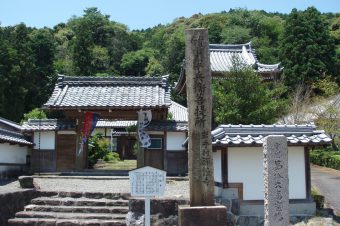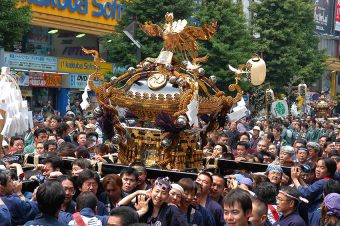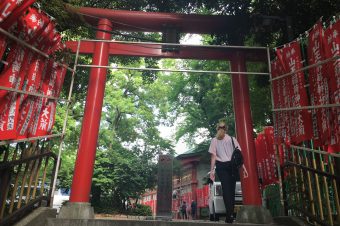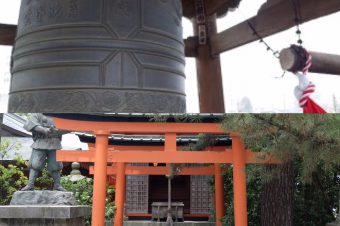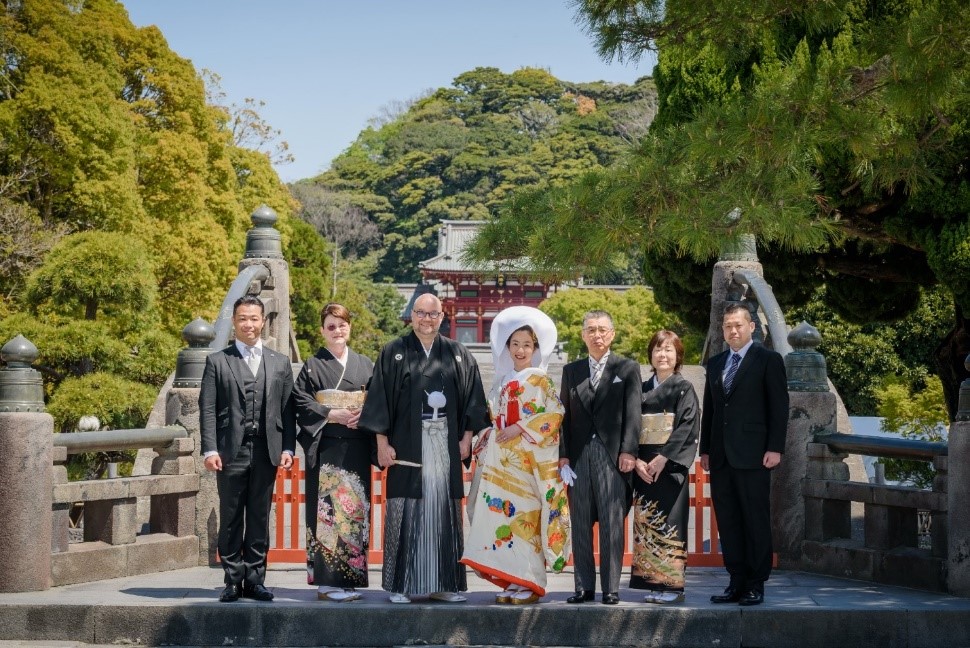
My wife and I were legally married (i.e submitted the form to City Hall) in late April of 2016.
About a week prior to the event, I enlisted the help of a friend to clear out the master bedroom which I had been using as a storeroom while I lived in the guest bedroom. When we started emptying an antique cabinet to lighten the load before lifting the cabinet up, my friend and I spotted a large garment wrapped in paper from Takashimaya, one of Japan’s high end department store chains. We opened up the garment to reveal two beautiful uchikake, or wedding kimonos. My friend remarked I should use these at my wedding ceremony. My reply was Masayo really didn’t want any sort of ceremony. He said, “too bad, because I think this is a sign your (deceased) mother wants these uchikake to be used. “ I just replied “shoganai” (can’t be helped) and we continued clearing out the bedroom.
The next day, when Masayo arrived for a visit, she confided to me she was thinking about having a Japanese style wedding ceremony after all, and inviting her family, but was afraid renting a wedding kimono would be very expensive. I just smiled and said, “We already have one. Two, actually.” To say she was shocked would be an understatement.
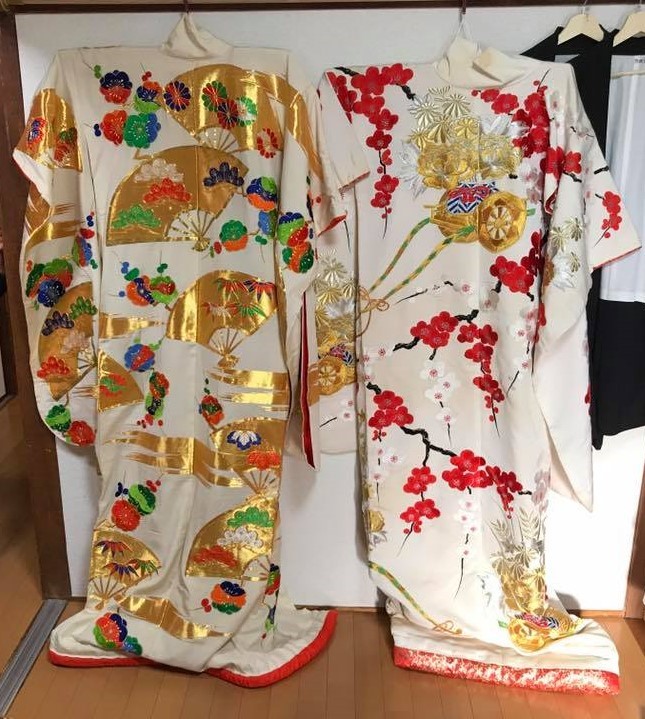
Naturally, being born and raised in Kamakura, the only place where I would consider having a Japanese wedding ceremony would be at Hachiman Shrine, in front of Kamakura’s patron deity. Masayo agreed. The next issue was when to have the ceremony. It had to be on a weekend so Masayo’s family could attend, plus it had to be a fortuitous day according to the Japanese almanac, and finally it had to be during the coming autumn or the following spring. Summer and winter were to be avoided, as the ceremony would take place at a shrine pavilion exposed to the elements on all four sides.
Once we were legally married, almanac in hand we walked to Hachiman Shrine to make a reservation. The first available date meeting all of our requirements was April 23, 2017. Almost a year away! However, that was to be expected, so we made the reservation and walked home.
For something as complicated as the preparation for a Japanese wedding, we decided professional assistance was the way to go, so the next week, we decided on which Kamakura wedding salon to contract with. What I had was the outermost bridal garment only. I think there are four or five layers involved, these plus all the necessary accoutrements would have to be rented. For the groom, everything would have to be rented. Then there is the hair arranging, makeup, rickshaw, photo shoots, etc . and so forth. Trust me, paying a professional to do all this is money very well spent.
As the groom, I would be wearing a formal haori and hakama. Think of these as a jacket and pants to fit over a base kimono. The jacket, or haori, is emblazoned with the groom’s official family crest, known as a kamon. This kamon would be temporarily placed on the wedding salon’s rental haori. As I didn’t have a kamon, I asked my good friend Yohsuke Takenaka, who hails from a very distinguished family, if I could borrow his family crest for the occasion. He readily agreed so I let the wedding salon know which one it was (officially known as Nine Bamboo-grass Leaves Within a Circle) and gave them a digital image for confirmation. I will talk more about this kamon later.
Hachiman Shrine highly recommends couples having their ceremony at the shrine attend one of the orientation sessions which are held every few months. Masayo and I ended up attending the March 2017 session. The orientation consists of a 20 minute video, followed by instructions on how to bow. Shrine personnel bow with a 90 degree angle, but know that would be impossible without training and practice, so they asked everyone else to please at least strive for 45 degrees.
This is the cool brochure we received at the orientation session.
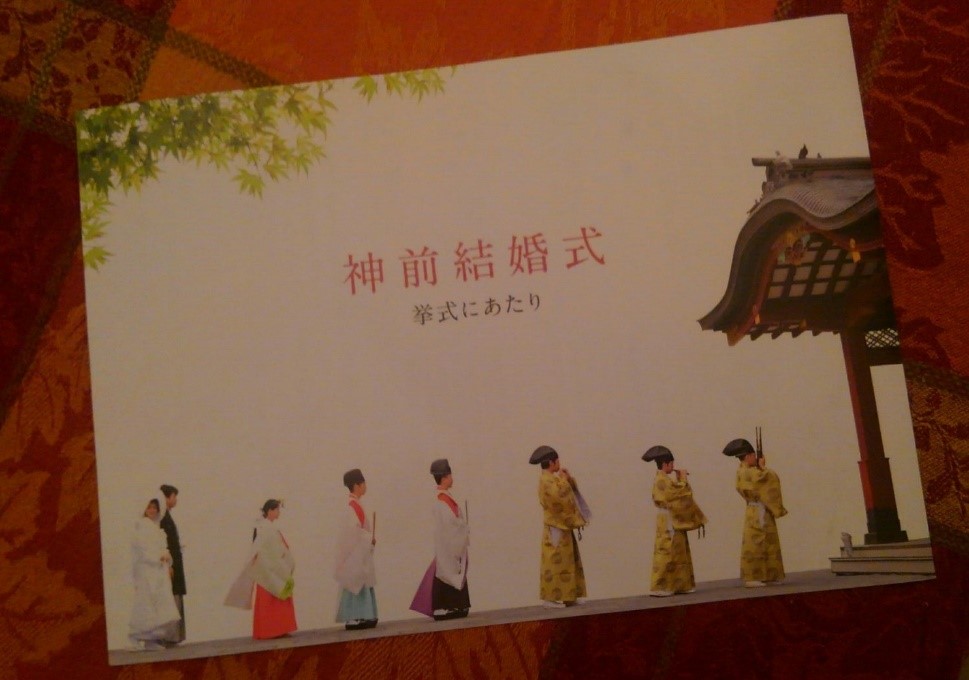
The day prior to the ceremony, I stopped by the wedding salon to drop off the two uchikake (which, incidentally, took about three weeks and 20000 yen to get dry cleaned) plus the snacks and drinks to stock the waiting room.
On the day of the ceremony, Masayo and my sister (who came from Seattle for the occasion) left the house around 530AM to be at the wedding salon by 6AM. (Our ceremony started at noon!) Hair and makeup take a very long time. Masayo’s mother didn’t require hair arranging or makeup, but still needed to be there by 8 to be dressed in a formal kimono. I got there around 830 to start getting dressed out in haori-hakama, and Masayo’s father around 9 for his formal coat with tails. Masayo’s brother and my friend Yohsuke Takenaka, representing the go-between, also arrived to round out the official party. (My elderly uncle would join us at the Hachiman Shrine waiting room just prior to the noon ceremony.)
Then we were off to a photo shoot at the small temple located next to the wedding salon.
After the photo shoot was finished, we went back to the wedding salon for about 20 minutes while Masayo changed her uchikake from the one used for the photo session to the one she would wear during the actual ceremony. The decorations in her hair were swapped out as well. The very last traditional Japanese ritual which took place at the wedding salon was for Masayo to get her lipstick touched up by her mother. In the olden days, when a bride went directly from her parents’ home to her husband’s home, this was the last thing the mother could ever do for her daughter. Even today, this was a pretty emotional moment.
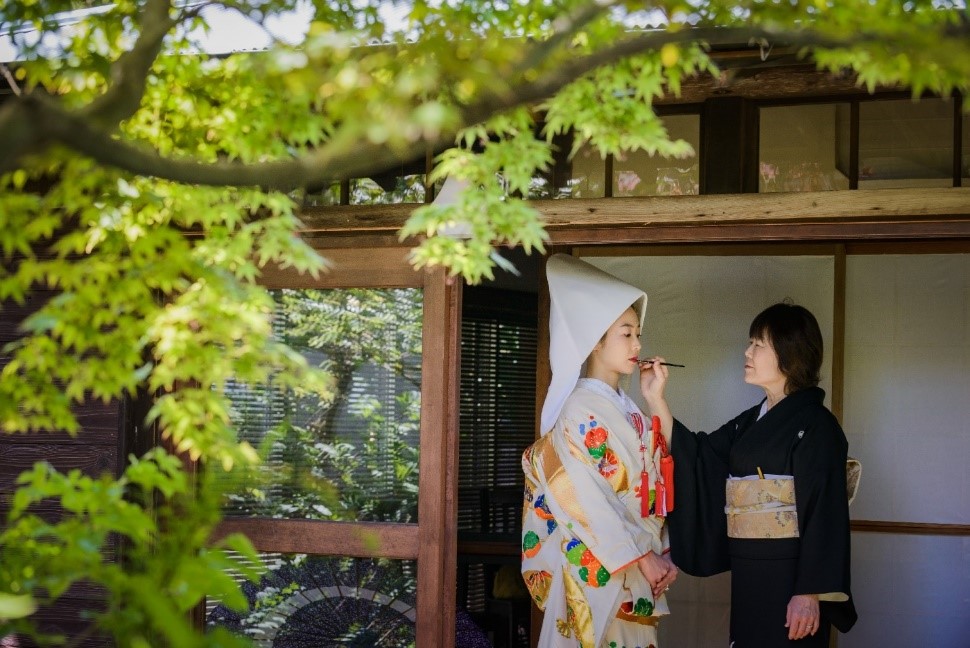
We then ventured back outside where our rickshaw awaited us. Only Masayo and I got to ride, everyone else had to hoof it to the shrine. The rickshaw driver (?) took us on a circuitous route to Hachiman Shrine, thereby allowing the walkers enough time to get there before our arrival.
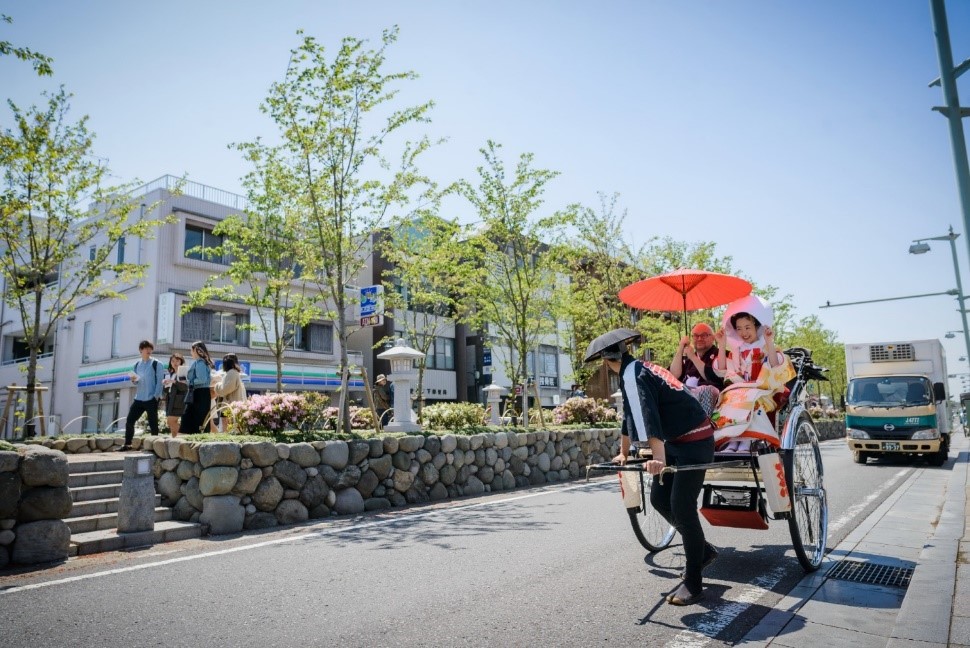
We arrived at Hachiman Shrine’s third torii gate, and the photo taking started happening in earnest. After about 30 minutes of picture taking, we were guided to the waiting room and received our final briefing from a shrine maiden, known as a miko-san. There, we first had to sign the pledge which I would read during the ceremony. Within the pledge itself Masayo’s maiden name is used, but within the final signature block for groom, bride and go-between her married name is used. Normally the groom writes in all the names, but since my Japanese handwriting is so atrocious probably even the gods couldn’t decipher it, I had Masayo write in everything.
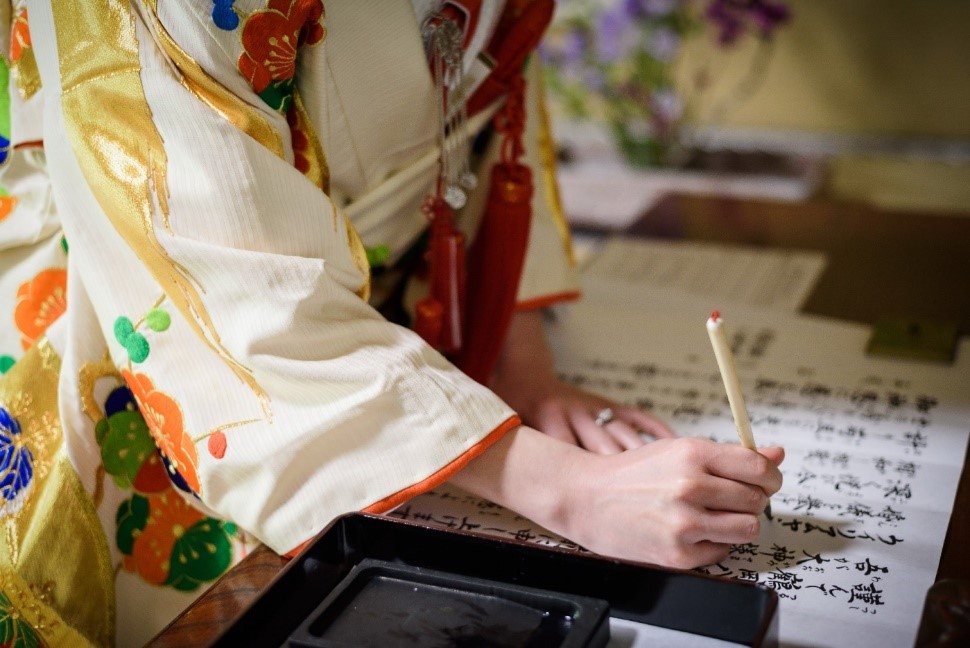
The next thing was to practice the Ritual Offering to the Deity (explanation later).
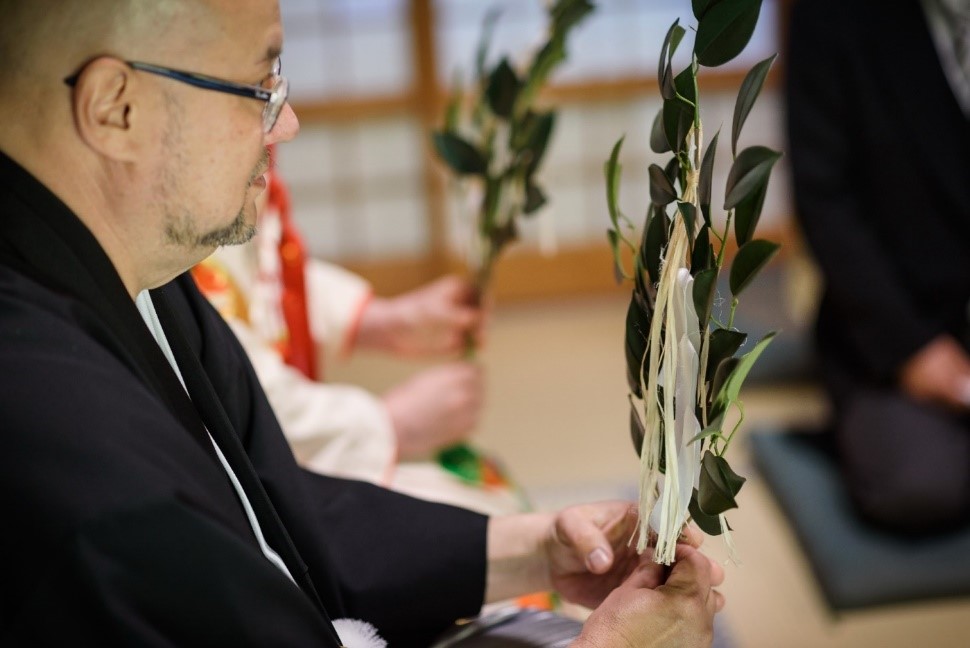
A few minutes before noon, we left the waiting room en route Hachiman Shrine’s Dance Pavilion. We stepped up into the Pavilion, took our assigned seats, and the following Sequence of Events took place:
Blessing by Head Priest – waving a sacred wand over all participants.
Report by Head Priest – done to inform the Hachiman Deity what was going to happen and requesting his blessing.
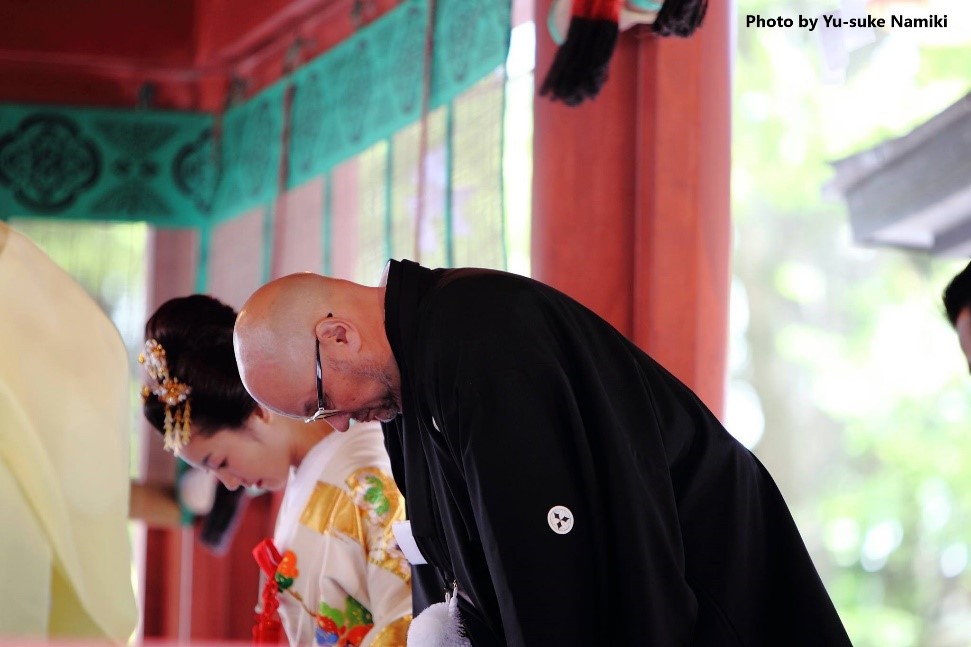
Dance by Shrine Maiden – done to place the deity in a good mood. Her dance was accompanied by shrine music on traditional Japanese musical instruments. This was actually done live by shrine musicians, it was not a recording!
Ritual sake drinking to signify unity – the priest first came in front of me with a tray loaded with a stack of three sake cups, large medium and small. First, I was offered the small sake cup, into which the shrine maiden poured a small amount of sake. I drank the sake using three sips. Well, actually, since there was so little sake the first two sips were faked. Next, the priest offered the sake cup to Masayo, who followed suit. Then, she took three sips from the medium cup. Next I took three sips from the medium cup, then three sips from the large cup. The event was finished by Masayo taking three sips form the large cup. The significance of the three sips from three cups for a total of nine sips is similar to the Western phrase “for better or for worse, in sickness and in health.” Three, or “san” is a very fortuitous number in Japan, and is a homophonic syllable used in many Japanese words with good connotations for a married couple. For example, the character 産, meaning “birth” and which also forms part of the word for “wealth,” is pronounced “san.” On the other hand, the number nine, pronounced “ku”, is a homophone for the character苦, meaning suffering, anguish, hardship etc.
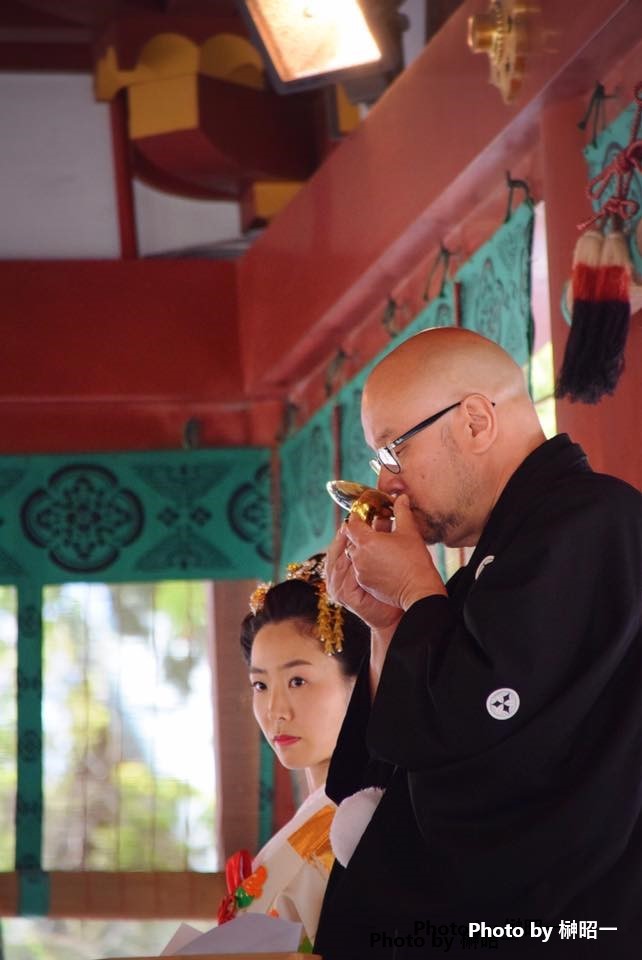
Groom’s Pledge – this is where Masayo and I stepped up to the central podium(?), then I read Masayo’s and my pledge to cherish each other and work together for the benefit of society.
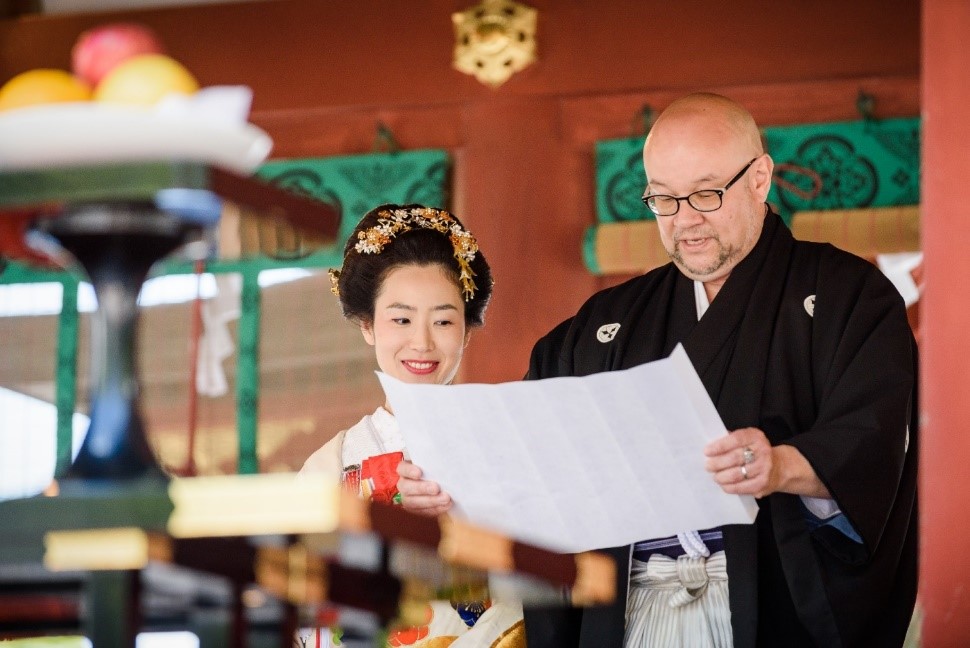
Ritual Offering to the Deity – Masayo and I each offered the deity a tamakushi, which is a branch of a sacred tree, decorated with paper strips.
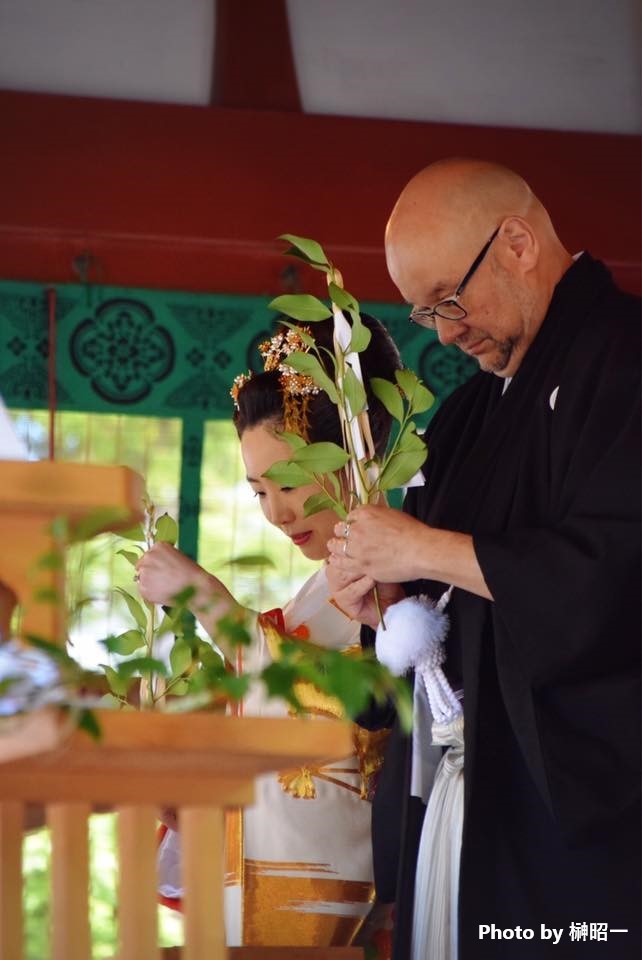
Next is an optional Exchange of Rings, which we declined.
Family and Relatives Toast – each family member and relative is poured a small amount of sake (they get to keep the cups), as are the bride and groom. The head priest then explains the drinking of sake together symbolizes every family member and relative present will do their best to support the bride and groom as they go through married life together. When cued by the head priest, everyone says Omedeto Gozaimasu (Congratulations) and drink sake together.
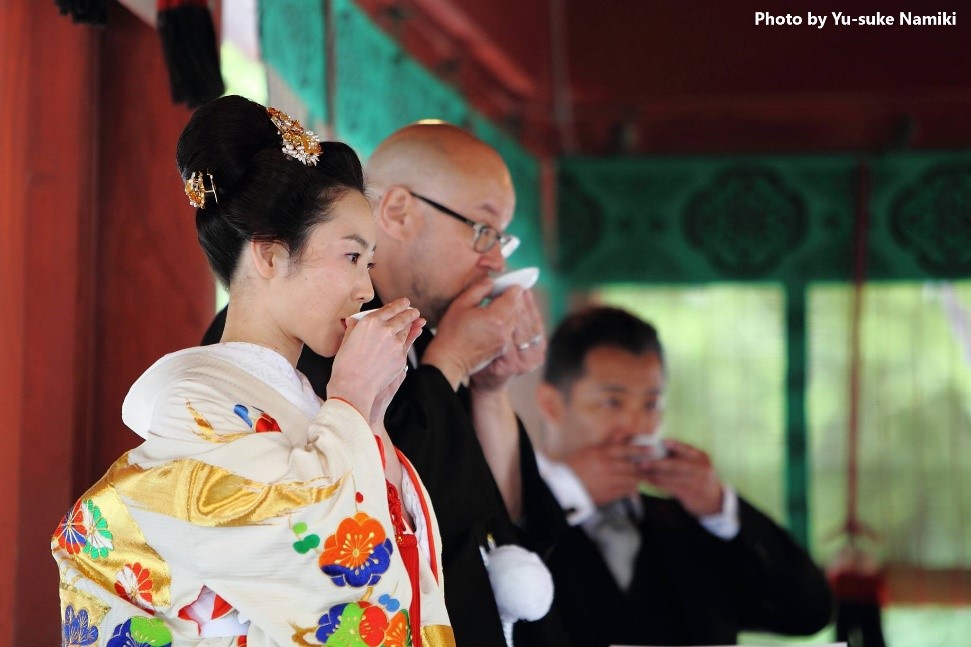
For us, it was time to get together with our friends whom had showed up just to view the ceremony from outside the Dance Pavilion, and take many, many pictures.
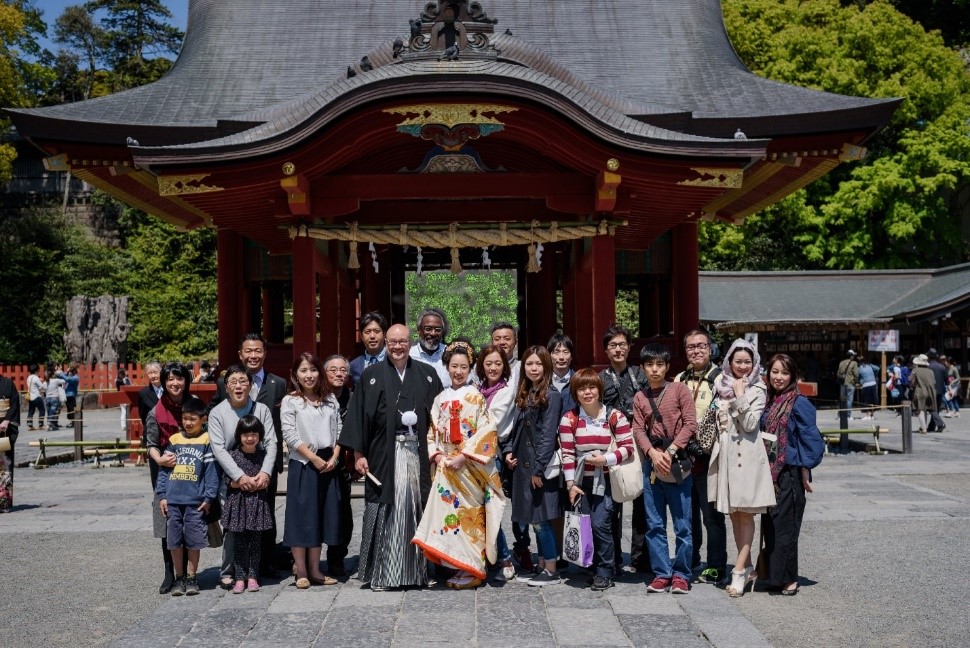
Postscript:
Those of you whom have been following my column in Sanpai Japan know I credit legendary feudal era general and brilliant military strategist General Hanbei Takenaka with bringing my wife and I together. This is why I really wanted to wear the Takenaka family crest on the haori for my ceremony, and so I asked my good friend (who also happens to be the general’s direct descendant) Yohsuke Takenaka if I could “borrow” it for the occasion. Yohsuke heartily agreed to let me borrow it.
Fast forward to the wedding ceremony day. In the Hachiman Shrine waiting room, in the interval between signing the pledge etc. and leaving for the Dance Pavilion, Yohsuke announced to everyone he had a gift for me. A gift which his family last presented in the late 16th century, to a young boy named Shoujumaru, who would later become famous as General Nagamasa Kuroda. Yohsuke said he was going to authorize me to use the Takenaka Family crest as my own, then presented me with the framed formal embroidery shown in the photo below.
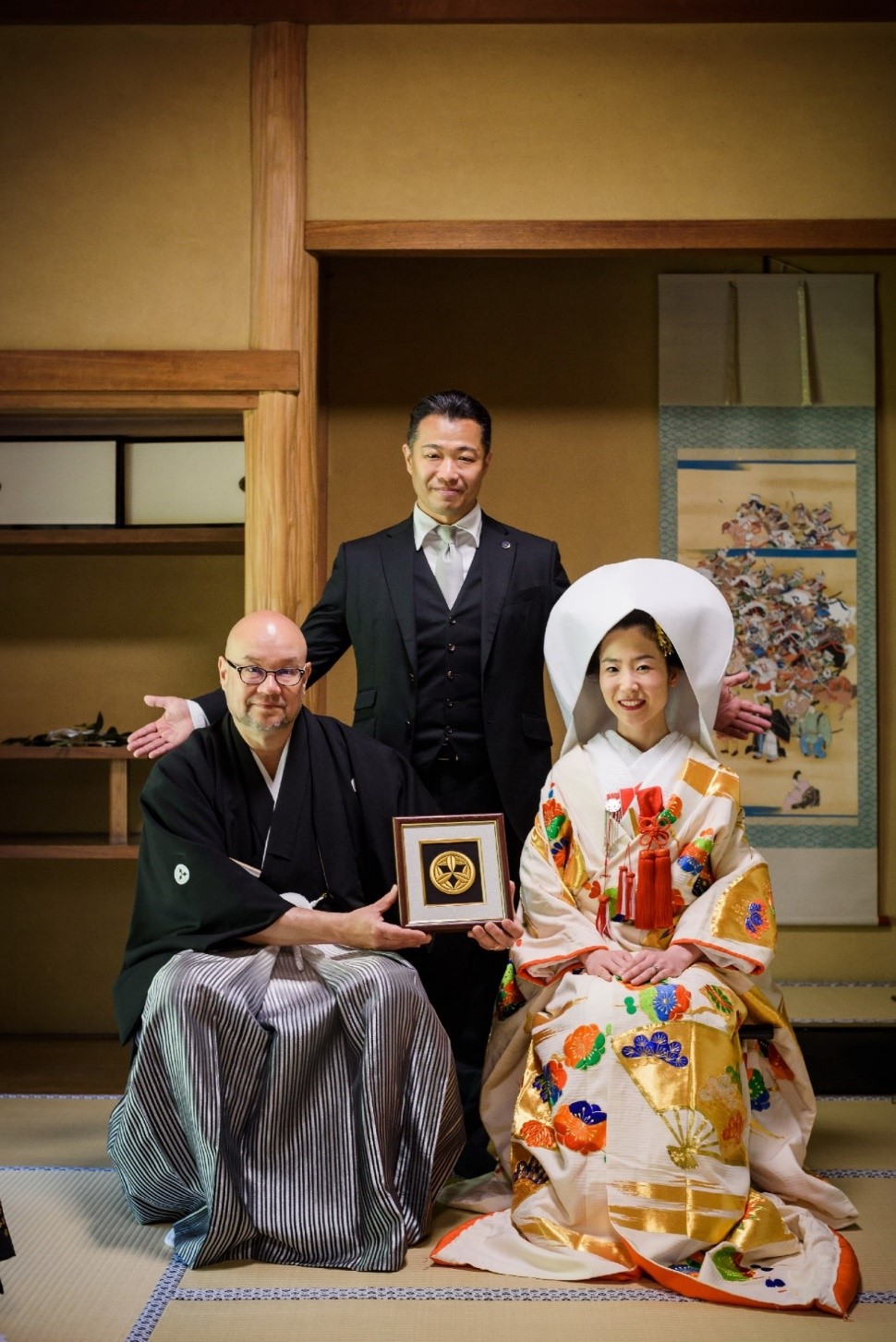
Wow!
It is hard to put into words without also providing a lot of background information, but the short version is: in Japan, this is a TREMENDOUS honor. So, when I stepped up into the pavilion to have my marriage formally recognized by Kamakura’s patron deity, I was wearing my own family crest.
Myself, my wife, and all our direct descendants will henceforth be able to wear the Takenaka Family crest as our own.
On the back side of the framed formal embroidery is this handwritten comment:
To William J. Young
As proof of our friendship,
I present the Takenaka Family crest “Nine Bamboo-grass Leaves Within a Circle”
to your household.
Takenaka Hanbei Shigeharu
17th generation direct descendant
Takenaka Yohsuke
Photographic credits: All photographs were taken by the ENISHI Wedding Salon photographer unless otherwise credited. (Except for the uncredited, poor quality photo of the brochure. That was me.)

